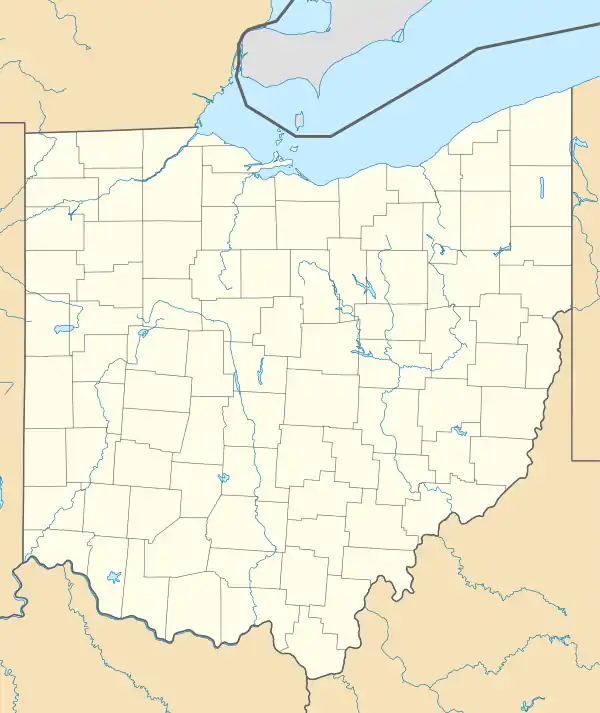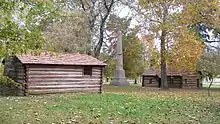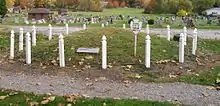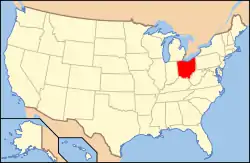Gnadenhutten massacre
The Gnadenhutten massacre, also known as the Moravian massacre, was the killing of 96 Christian Lenape by U.S. militiamen from Pennsylvania on March 8, 1782 at the Moravian missionary village of Gnadenhutten, Ohio during the American Revolutionary War.[2] More than a century later, Theodore Roosevelt called the massacre "a stain on frontier character that the lapse of time cannot wash away".[3]
| Gnadenhutten Massacre | |||||||
|---|---|---|---|---|---|---|---|
| Part of the American Revolutionary War | |||||||
 This 37 foot (11 m) monument, located next to a reconstructed mission house in what was the center of the original village, was dedicated on June 5, 1872. The inscription reads: "Here triumphed in death ninety Christian Indians, March 8, 1782."[1] | |||||||
| |||||||
The site of the village has been preserved. A reconstructed mission house and cooper's house were built there, and a monument to the dead was erected and dedicated a century later.[4] The burial mound is marked and has been maintained on the site; the village site has been listed on the National Register of Historic Places.
Background
Gnadenhutten Massacre Site | |
 | |
| Nearest city | Gnadenhutten, Ohio |
|---|---|
| Coordinates | 40°21′15″N 81°26′6″W |
| Built | 1782 |
| NRHP reference No. | 70000519 [5] |
| Added to NRHP | November 10, 1970 |
During the American Revolution, the Munsee- and Unami-speaking Lenni Lenape (also called Delaware) bands of the Ohio Country were deeply divided over which side, if any, to take in the conflict. The Munsee were generally northern bands from around the Hudson River and upper Delaware River originally. The Unami were from the southern reaches of the Delaware.
Years earlier, many Lenape had migrated west to Ohio from their territory on the mid-Atlantic coast to try to escape colonial encroachment, as well as pressure from Iroquois tribes from the north based around the Great Lakes and western New York. They resettled in what is now Ohio, with bands in several villages around their main village of Coshocton.[6] These villages were named Schoenbrunn, Gnadenhutten, and Salem, and located on what was then called the Muskingum River. Modern geography places Coshocton on the Muskingum River and the three smaller villages on the Tuscarawas River.
By the time of the Revolutionary War, the Lenape villages lay between the opposing interests, which had western frontier strongholds on either side: the rebel American colonists' military outpost at Fort Pitt (Pittsburgh) and the British with Indian allies around Fort Detroit, Michigan.
Some Lenape decided to take up arms against the American colonials and moved to the northwest, closer to Fort Detroit, where they settled on the Scioto and Sandusky rivers. Those Lenape sympathetic to the United States remained at Coshocton, and leaders, including White Eyes, signed the Treaty of Fort Pitt (1778) with the Americans.[7] Through this treaty, White Eyes intended to secure the Ohio Country as a state to be inhabited exclusively by Native Americans, as part of the new United States.
A third group of Lenape, many of them converted Christian Munsee and Unami, lived in several mission villages in Ohio led by David Zeisberger and other Moravian Christian missionaries. From the mid-Atlantic area, they spoke the Munsee and the Unami dialects of Delaware, an Algonquian language.
White Eyes, a Lenape chief and Speaker of the Delaware Head Council, negotiated the treaty. When he died in 1778, reportedly of smallpox, the treaty had not yet been ratified by Congress. United States officials never pursued it, and the Native American state was dropped. Years later, George Morgan, a colonial diplomat to the Lenape and Shawnee during the American Revolution, wrote to Congress that White Eyes had been murdered by American militia in Michigan.[7]
Many Lenape at Coshocton eventually joined the war against the Americans, in part because of American raids against even their friendly bands. In response, Colonel Daniel Brodhead led an expedition out of Fort Pitt and on 19 April 1781 destroyed Coshocton. Surviving residents fled to the north. Colonel Brodhead convinced the militia to leave the Lenape at the Moravian mission villages unmolested since they were peaceful and neutral.
Brodhead's having to restrain the militia from attacking the Moravian villages was a reflection of the brutal nature of frontier warfare. Violence had escalated on both sides. Relations between regular Continental Army officers from the East, such as Brodhead, and western militia were frequently strained. The tensions were worsened by the American government's policy of recruiting some Indian tribes as allies in the war. Western militiamen, many of whom had lost friends and family in Indian raids against settlers' encroachment, blamed all Indians for the acts of some and did not distinguish between friendly and hostile tribes or bands.
Removal and massacre

In September 1781, British-allied Indians, primarily Wyandot and Delaware, forced the Christian Indians and missionaries from the Moravian villages. They took them northwest toward Lake Erie to a new village, called "Captive Town", on the Sandusky River. The British took the missionaries David Zeisberger and John Heckewelder under guard back to Fort Detroit, where they tried the two men on charges of treason. The British suspected them of providing military intelligence to the American garrison at Fort Pitt. The missionaries were acquitted during the trial.
The Indians at Captive Town were going hungry because of insufficient rations. In February 1782, more than 150 were allowed to return to their old Moravian villages to harvest the crops and collect stored food they had been forced to leave behind. The frontier war was still raging. In early March 1782, the Lenape were surprised by a raiding party of 160 Pennsylvania militia led by Lieutenant Colonel David Williamson. The American militia rounded up the Christian Lenape and accused them of taking part in raids into Pennsylvania. Although the Lenape denied the charges, the militia held a council and voted to kill them. Refusing to take part, some militiamen left the area. One of those who opposed the killing of the Moravian Lenape was Obadiah Holmes, Jr. He wrote:
"one Nathan Rollins & brother [who] had had a father & uncle killed took the lead in murdering the Indians, ...& Nathan Rollins had tomahawked nineteen of the poor Moravians, & after it was over he sat down & cried, & said it was no satisfaction for the loss of his father & uncle after all".[8]
After the Lenape were told of the American militia's vote, they requested time to prepare for death and spent the night praying and singing hymns. They were held in two buildings, one for men and one for women and children.
The next morning on 8 March, the militia brought the Lenape to one of two "killing houses", one for men and the other for women and children. The American militia tied the Indians, stunned them with mallet blows to the head, and killed them with fatal scalping cuts. In all, the militia murdered and scalped 28 men, 29 women, and 39 children. Two Indian boys, one of whom had been scalped, survived to tell of the massacre. The militia piled the bodies in the mission buildings and burned the village down. They also burned the other abandoned Moravian villages.
The American militiamen looted the villages prior to their burning. The plunder, which needed 80 horses to carry, included everything which the people had held: furs for trade, pewter, tea sets, and clothing. A few years later, missionary Heckewelder collected the remains of the Lenape and buried them in a mound on the southern side of the village.
Aftermath

Although many settlers were outraged by the Gnadenhutten massacre, frontier residents, embittered by the ferocious warfare, generally supported the militia's actions.[9] Despite talk of bringing the murderers to justice, no criminal charges were filed and the conflict continued unabated.
The Lenape allies of the British sought revenge for the Gnadenhutten massacre. When General Washington heard about the massacre, he ordered American soldiers to avoid being captured alive, as he feared what the hostile Lenape would do to captured Americans.
Washington's close friend William Crawford was captured while leading an expedition against Lenape at Upper Sandusky, Ohio. Crawford had not been at Gnadenhutten but was killed in retaliation.[10]
Captain Charles Bilderback had participated in the Gnadenhutten massacre and was a survivor of the June 1782 Crawford expedition. Seven years later, in June 1789, he was captured by hostile Lenape in Ohio, who killed him.[11] David Williamson, the officer who led the Gnadenhutten massacre, was also a survivor of the Crawford expedition. In 1814, decades after the war, he died in poverty. The leader of the Home Guard at the time was Captain John Hay who on November 24 led an attack on the Delaware.
In 1810, Tecumseh reminded future President William Henry Harrison, "You recall the time when the Jesus Indians of the Delawares lived near the Americans, and had confidence in their promises of friendship, and thought they were secure, yet the Americans murdered all the men, women, and children, even as they prayed to Jesus?"[12]
In 1889, future president Theodore Roosevelt called the atrocity "a stain on frontier character that the lapse of time cannot wash away".[3]
Memorialization
The village site has been preserved and is listed on the National Register of Historic Places. The state reconstructed a typical mission house and cooper's shop on the site of the village. A monument was erected in honor of those massacred, near the burial mound.
Representation in culture
- Western writer Zane Grey included a fictional treatment of the Gnadenhutten Massacre in his historical novel The Spirit of the Border (1906).
- Dancing through Fire (2012) by JoAnn Hague is a novel exploring the events from 1775 to 1782 which culminated in the massacre. Under the working title, Huts of Grace, the book won a 1984 Ohio Arts Council Fellowship Grant in Creative Writing.
- Trumpet in the Land, a long-running outdoor drama in Ohio, depicts the Gnadenhutten massacre and the events leading up to it.
- Lucy Ellmann mentions the Gnadenhutten massacre in Ducks, Newburyport.
References
- Tuscarawas, Freepages, Rootsweb.
- "Gnadenhutten", Ohio History Central (Retrieved 2018-06-30.
- Roosevelt, Theodore, The Winning of the West, Volume 2, p. 145. G. P. Putnam's Sons, 1889.
- "Archived copy" (PDF). Archived from the original (PDF) on 2013-01-21. Retrieved 2015-04-28.CS1 maint: archived copy as title (link)
- "National Register Information System". National Register of Historic Places. National Park Service. April 15, 2008.
-
 William Dean Howells, “Gnadenhütten,” Three Villages, Boston: James R. Osgood and Co., 1884., accessed 19 Mar 2010
William Dean Howells, “Gnadenhütten,” Three Villages, Boston: James R. Osgood and Co., 1884., accessed 19 Mar 2010 - Wellenreuther, Hermann. "The Succession of Head Chiefs and the Delaware Culture of Consent: The Delaware Nation, David Zeisberger, and Modern Ethnography", In A. G. Roeber, ed., Ethnographies and Exchanges: Native Americans, Moravians, and Catholics in Early America. University Park, Pa.: Pennsylvania State University Press, 2008. 31–48.
- COL. J. T. HOLMES, THE AMERICAN FAMILY OF REV. OBADIAH HOLMES (Columbus, Ohio: 1915)
- Eckert, Allan W. (2001). The Frontiersmen: A Narrative. Ashland, Kentucky, USA: Jesse Stuart Foundation. p. 252. ISBN 978-0945084914.
- Belue, Ted Franklin. "Crawford's Sandusky Expedition", The American Revolution, 1775–1783: An Encyclopedia 1: 416–420. Ed. Richard L. Blanco. New York: Garland, 1993. ISBN 0-8240-5623-X.
- Howe, Henry. Howe's Historical Collections of Ohio. 1. pp. 589–90.
- Tecumseh's Speech of August 11, 1810
Further reading
- Catalano, Joshua (2019). The Settler-Colonial Memory of the Gnadenhutten Massacre and the Burning of William Crawford (PhD). George Mason University.
- Dowd, Gregory Evans. A Spirited Resistance: The North American Indian Struggle for Unity, 1745–1815. Baltimore: Johns Hopkins University Press, 1992.
- Harper, Rob. "Looking the other way: the Gnadenhutten massacre and the contextual interpretation of violence." William and Mary Quarterly (2007): 621–644. in JSTOR
- Howells, William Dean (1869). "Gnadenhütten". The Atlantic Monthly. 23 (135): 95–114. Retrieved 2019-09-23.
- Olmstead, Earl P. Blackcoats among the Delaware: David Zeisberger on the Ohio Frontier. Kent State University Press, 1991.
- Wallace, Paul A. W., ed. Thirty Thousand Miles with John Heckewelder. 1958/ Wennawoods reprint 1998.
- Weslager, C. A. The Delaware Indians. New Brunswick, New Jersey, 1972.

